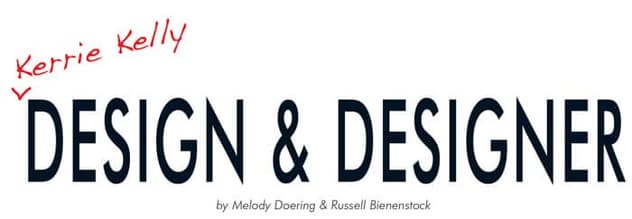
Author, retailer, interior and product designer Kerrie Kelly talks about consumers, design trends, customer engagement and retailing.
For this installment of Design & Designer, Furniture World spoke with award-winning designer, author and multi-media consultant, Kerrie Kelly. Kelly founded Kerrie Kelly Design Lab and 42nd Street Design, a case goods brand “for designers, by designers”, located in Sacramento, California. She also collaborates with furniture, rug and accessory manufacturers on her Kerrie Kelly branded lines sold through home furnishings retailers.
Kerrie’s professional associations range from being a Fellow and Board Member of the American Society of Interior Designers to being a Certified Aging-in-Place Specialist. In addition to having written two books, Home Decor: A Sunset Design Guide with Sunset Books, and My Interior Design Kit, with Pearson Professional and Career Education, Ms. Kelly is a regular columnist for Style Media Group.

Nights and Weekends
We asked Kerrie about how she started as a designer.
“I went to Cal Poly in San Luis Obispo, for interior design, and have a Master’s degree in business. But I really do feel that there were second and third educations along the way.
“I started out in retail with Ralph Lauren Home Collection, as their California buyer. I was there for five years before joining Del Webb, a home builder specializing in active-adult homes and communities. At both companies I did interior design work on the side, offering products that Ralph Lauren didn’t at the time, such as lighting and paint. Working nights and weekends, I helped clients to complete their look. At Del Webb, clients wanted their houses to look like the models we had designed. Again, on nights and weekends, I sold rugs, furniture, and art work to home buyers – all things that Del Webb didn’t provide.”
Moving On and Up
“When Pulte Homes acquired Del Webb Corporation, the offerings became streamlined, production homes, so I decided to turn my side business into a full-time one. I moved my office from a bedroom to a storefront: Kerrie Kelly Design Lab, in northern California.
“We have a team of seven designers who do mostly residential work. 42nd Street Design is the retail portion of the studio. We feature the casegoods furniture line we design, as well as upholstery pieces and smaller accessory items like pillows, candles, and gifts.
“At 42nd Street Design, clients can pick exterior and interior finishes, hardware, and fabric – we can tweak their choices – all sold under the 42nd Street label.”
Inspirational People
“I am so grateful for my opportunity to work for Mr. Lauren in the ‘90s. He helped shape my design eye, and working for him was an education in itself. Several years ago, I was able to interview family members of Charles and Ray Eames for my book, My Interior Design Kit. I was humbled by their drive, talent, and brains for innovation. I also had the opportunity to interview architect Michael Graves. He told me, ‘Sketch, sketch, sketch your ideas, no matter how good (or bad) you think you are at it! Just keep sketching.’ And that is exactly what I have done with each of my product lines.”
Design Perspective
What is your perspective on furnishing homes? Does it differ from others in the furniture industry?
“Like many of Furniture World’s design-oriented retail readers, we work with a variety of budgets. Our work complements a range of lifestyles and taste levels, but the reality is, we’re incorporating items that come out of clients’ attics, which may not be our first design choice. But that’s OK. It’s our mission to help people tell their style-story by adding pieces that make sense, have comfort and functionality. We want to create spaces that enhance our clients' lives – be places that they can enjoy, have family celebrations, and that support their lifestyles.”
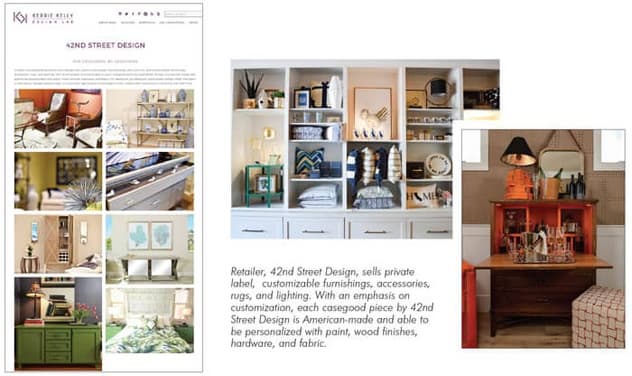
Creating a Home Story
“Before the most recent recession, people used to open up a magazine and say, ‘I want my house to look like that!’ And we would respond, ‘That is Will Smith’s house. Why would you want your house to look like his house? Let’s have it look like your house instead.’
“The details of interior design are what make spaces become special to clients and their families. It’s a ‘home story,’ which any good designer or retailer can help create. Telling a home story can be as simple as adding nail-head trim, or contrasting welts so an upholstered piece becomes special. Retailers can also differentiate themselves and tell this kind of value story on their showroom floors.
“For retailers who carry designer-branded lines, it’s helpful to add another layer of story-telling. By collaborating with manufacturers, they can create looks that tell the product designer’s journey. I would encourage retailers to hold more events, perhaps inviting product designers to appear at continuing education events, or a meet and greet. It’s a great way to bring in customers and increase perceived value.”
Telling the Stories
“When reps come to our retail store, we ask them to tell us the top three highlights of their products. We take this information and incorporate it into presentations we share with clients. Visiting a factory, or knowing that a company has been in business for 45 years, or learning about an element that makes a product special, helps us craft the stories we relate.
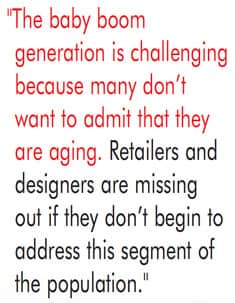
“Ideally, the stories we tell are aspirational, as well. We’re in a visual business, so whether you are communicating at your place of business, via online platforms like Instagram, Pinterest, or Houzz, in print or other media, it’s important to focus on telling brand and product stories that inspire and give potential customers insight into how you can help them to achieve a better way to live.
“We find blogging is a useful tool for us. At our blog [kerriekelly.com/blog] we present lots of aspirational content in features like ‘Steal Our Style,’ and ‘Get the Look.’ We also have a little feature that we call ‘The Dressed Nest’ that details how we put someone’s house together, what it looked like before, and the layers that were added to arrive at the ‘after’ photos. Providing this kind of information can also help retailers to inspire customers. We build trust through storytelling, breaking down the process and showing how we help people get to the final picture.”
Providing Great Design
We asked Kerrie to sketch out her process of working with a new client.
“We have an interview process with each client. Our team has decided that the first step is to understand our customer’s vision, so we interview them free of charge. We want to be sure that we can help them change their living environment in a positive way, and in a way that fits their needs.
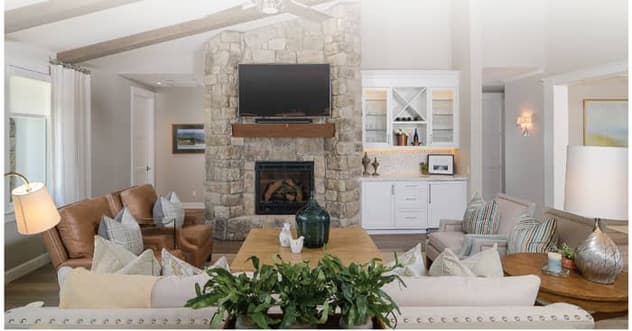
“Our tagline is, 'Everyone Deserves Great Design™'. There are a variety of ways to provide that. We can reach people through blogging, providing inspiration through social media, or via the books I’ve written.”
Design for Aging
“There are millions of aging baby boomers in this country right now, and we want to help them. It is a growing market. That doesn’t mean that designers or furniture retailers need to get involved in selling and installing grab bars, ramps, or furnishings that overtly signal aging or physical challenges. Rather, we want to create spaces that are sleek, beautiful, and functional.
“The baby boom generation is challenging because many don’t want to admit that they are aging – it can be a hard conversation to have. Retailers, designers, and others in our industry are missing out if they don’t begin to address this segment of the population.
"We look for creative ways to assist people. Our approach is to present great design, versus design for aging. We’ve had a lot more success this way. It is part of a larger conversation about livability. If you are an interior designer or a furniture retailer, it’s important to address the versatility of pieces and their level of performance in the home.
“We want to create spaces where kids are able to play, where their parents can entertain, where grandma feels comfortable, and furniture is able to be moved around. People are enjoying their homes more than ever, and today’s consumers have a need for low-maintenance furnishings with a high durability factor. We as an industry need to make that accessible.”
Multi-purpose Furnishings
“Multi-purpose and multi-function furnishings are a definite product advantage trend. A dining room chair can be moved with ease into a family room when it’s game night, and everything still looks great together. It’s a consumer benefit to feature pieces that can be adapted and re-purposed in other settings.
“Rooms can be designed to be a bit like the W Hotel. When you enter the first floor, there’s a bar and a lounge area, and it looks perfectly set at seven o’clock in the morning. But come five o’clock, someone’s dragging up an ottoman, and someone’s bringing up another chair, and now there is an intimate area for two or a group setting for 12. All those pieces can move around and morph into something else.
“We are also seeing an interest in products offering greater performance, allowing people to entertain, kids and pets included, with everyone being able to join in the fun without damage to furniture finishes, fabrics, and rugs.”
Industry Collaboration
We asked Kerrie about collaboration in the industry.
“Although there is a place for celebrity designers who don’t have a deep background in interior or product design, the focus of many brands has evolved to understand that if they work with the interior design industry, they need to collaborate with designers who have a client base and some expertise in working with products.
“For example, I work with Feizy Rugs, and I feel like I can contribute to the rug conversation. I can tell our story here in California with their outdoor line, and create products that are right for how we specify products for clients today.
“As designers work with clients, we discover gaps in the offerings of the brands we specify and love. There are moments, even with great brands, when we wish they would have ‘this’ product – or think, ‘If only we could have ‘that’ item.’ Today’s designers feel more comfortable pitching design ideas to manufacturers, and more manufacturers are embracing those ideas.”
Establishing Trust
How can retailers maintain old-fashioned trust in a world of online retailing?
“It is essential for retailers to have a robust online brand presence. Although people often say, ‘I have to sit in a chair before I can buy it,’ the fact is that people are more comfortable with shopping for furnishings online than ever before. There is the advantage of allowing potential buyers to consider a look or an aesthetic without sales pressure. Buyers can take time to search for what they want at their specific price point.
“It may be that they just visited a store, or are only shopping online. Either way, when they do decide (perhaps at 11 o’clock that night) to buy that sofa, it’s possible to capture the sale. Consumers want instant gratification, and e-commerce offers just that.
“To establish trust, sometimes getting back to basics is the answer. With all that people deal with in their lives, it is surprising and gratifying to encounter someone who does make the time to take that extra step. Whether it’s a retailer who writes a thank-you note, or one who provides excellent service and follow-through, they have found the keys to building a relationship.”
Changing Consumers
We asked Kerrie if she thought that consumers have changed.
“Especially when working with the millennial market, loyalty is a different proposition. People come into our shop in midtown, use their Amazon app, take a picture, and then try to find the item elsewhere for less. They also want to tout that they shop locally, which can be an opportunity for us.
“We find that Baby Boomers are looking for furnishings that are more sleek and simplified. They have a design aesthetic that most Millennials want, but usually can’t afford. The boomers have the money, which makes them prime targets for furniture retailers.
“Some Millennials do have the means to buy quality, but often quality is not as big an interest for them as speed. We find that many don’t want to wait 12 weeks for a sofa to be made. We try to convince them it’s worth the wait, and we talk them through the pros and cons to find what’s important for each individual.”
TRENDS: Emerging
How do you see trends emerging? And which ones do you foresee will influence the industry both as a whole and in specific areas?
“Anyone in the design end of our business can benefit from getting beyond their four walls. For me, finding inspiration always involves meeting with people and traveling. It can come from anywhere. The trends in fashion are important to watch as a forecasting tool, and going to markets, like High Point, Vegas, Dallas, is always key. A wealth of knowledge and ideas can be collected to share with clients and customers.
“International shows are important as well. Trends I see in Milan are about three years ahead, versus High Point at about six months. It’s both fun and useful to plan for those trends coming down the pipeline, and forecast how European trends will translate in North America.

“At the Milan show a few years ago, for example, we saw a huge trend of contrast: shiny and matte; black and white. Knowing that this trend would come here in perhaps three to five years, we started using navy blue because we knew that our clients could feel comfortable with a classic navy, but weren’t ready for the harsh contrast of black and white. The plan became to transition our clients into those darker tones over time.
“European designers are often style leaders because they tend to be rooted in a rich history of classic design. It’s proven to be a great launching point for them to bring their designs into the modern day. I am inspired by what I see in Europe and how they turn everything on its head – it’s a great source of ideas for designers and retailers. There is innovation coming from the United States as well. Here in California we are showing people how to live well, especially when it comes to outdoor living and wellness.”
TRENDS: Styles and Furniture
“Chip and Joanna Gaines have had a huge influence on the market when it comes to style. While the farmhouse style continues to be popular, people are looking for something a bit different. There’s so much white with the farmhouse look, that people are finding it hard to maintain, especially with growing families. They want to add color to their space.
“We are seeing dark colors like charcoal used on walls with contrasting honey-colored furniture. There are large-format florals in both wall coverings and fabrics. Saturated jewel-tone velvets provide brilliant pops of color, while a more muted contrast of navy blue and blush remains a classic. The art of faux marbling is re-emerging in both art and fabrics.
“Oxidized elements, in tile, artwork, and wall treatments, were everywhere in the January markets. Retailers can easily incorporate this trend by featuring indoor or outdoor furniture with oxidized metal elements. Coffee tables, for example, with metal frames and metal accents can be a good addition to the sales floor. Retailers should look for metals like copper that achieve beautiful blue and green patina shades over time.”
TRENDS: Mixing It Up
“Today there is more room for being eclectic, and the line is being blurred between indoor and outdoor living. We ask clients the same questions when it comes to outdoor living as we do for indoor spaces, because there are new fabrics, materials, and design elements that perform well in both environments. From a design perspective, it allows us to pick a palette for an entire house that spills outdoors, visually and physically expanding the square footage.”
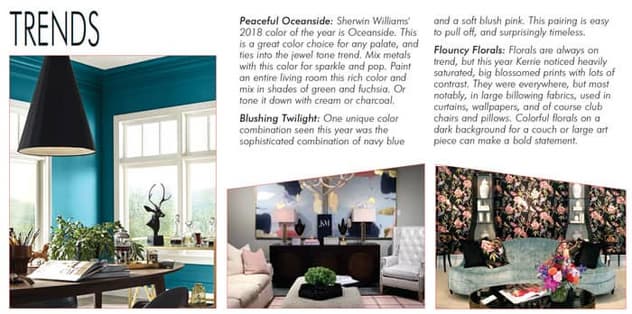
TRENDS: Color and Comfort
“I still say that navy blue is the color of the decade. I am seeing and using white paired with navy blue for a crisp effect. To that we’re adding metallics. We also encourage people to consider the fifth and sixth walls of their rooms – for furniture retailers these are often neglected. Look up, and there can be statement lighting, or maybe even wallpaper on the ceiling. And then down on the floor an impactful statement can be made with indoor or outdoor rugs.
“People are more willing to add a little personality to their outdoor spaces. The Coast to Coast collection we created for Feizy has a chain link pattern and bold, bright colors that come from nature. They have a playfulness to them.
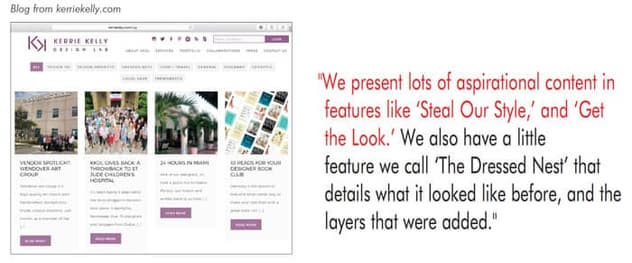
“People want their spaces to be cozy and inviting, playing into the Hygge trend. For those who choose a farmhouse look, adding texture is vital to develop personality and interest in a space. In addition, low-maintenance, durable furniture is becoming available at a wide range of price points. Innovation in areas like printing technology and linen-like polyester fabrics means durable does not have to be dull.”
TRENDS: California Style
“People, especially those who live in California, aspire to simplify, to live in smaller spaces as opposed to McMansions. There is energy behind the ‘lock and leave’ concept: low maintenance homes that are easy to lock up, allowing their owners not to worry too much about what goes on while they are away. We do a lot of bachelor pads that end up being really wonderful spaces, townhouse-type or loft concepts – perfect for people who travel frequently.”
TRENDS: Sustainable
“Psychologically, sustainable design consciousness is trending. While feeling powerless because of world events, clearing possessions becomes something a homeowner can do to reassert control. It rewards them with the notion that they can do something at home that won’t cost money, and can even give back to the community by recycling or selling their items. Emotionally, they feel better, and visually they can see the impact in their homes.
“Retailers can take advantage of this trend by showing vignettes that are clean, simple, and organized. They can encourage a clutter-free environment that supports a shopper’s lifestyle. This everything-in- its-place mentality fits Millennials (the Instagram-worthy home) and Boomers (shaping and editing the empty nest) alike.”
TRENDS: Wellness
“We Americans are spending more than 90 percent of our time indoors, and it’s becoming evident that there’s a huge disconnect between us as human beings and nature. Our bodies were created to be outside and moving, not sitting at desks for eight hours a day.
“True wellness is accomplished by improving things, like air and water quality, and by designing acoustical, mental, visual and thermal comfort. Lighting, for example, can greatly influence our health and biological functions. Light influences many different parts of our bodies and dictates our sleeping patterns. The introduction of circadian lighting that mimics natural lighting, is helping to ground us as human beings within our work environments.
“Retailers can be a part of this trend by offering furnishings that encourage wellness indoors and out. Sustainable fabrics and materials enhance this part of the wellness story.”
Furniture World is the oldest, continuously published trade publication in the United States. It is published for the benefit of furniture retail executives. Print circulation of 20,000 is directed primarily to furniture retailers in the US and Canada. In 1970, the magazine established and endowed the Bernice Bienenstock Furniture Library (www.furniturelibrary.com) in High Point, NC, now a public foundation containing more than 5,000 books on furniture and design dating from 1620. For more information contact editor@furninfo.com.